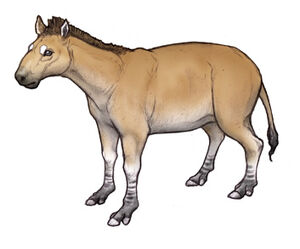
Mesohippus
Mesohippus is Greek for Middle Horse.
Description[]
Historical Epoch: Late Eocene-Middle Oligocene (40-30 million years ago)
Size and Weight: About four feet long and 75 pounds
Diet: Twigs and fruit
Distinguishing Characteristics: Small size; three-toed front feet; large brain relative to its size
About Mesohippus[]
You can think of Mesohippus as Hyracotherium (the ancestral horse previously known as Eohippus) advanced a few million years: this prehistoric horse represented an intermediate stage between the smallish hooved mammals of the early Eoceneepoch, about 50 million years ago, and the large plains grazers (like Hipparion and Hippidion) that dominated the Pliocene and Pleistocene epochs over 45 million years later. This horse is known by no less than twelve separate species, ranging from M. bairdi to M. westoni, which roamed the expanse of North America from the late Eocene to the middle Oligocene epochs.
About the size of a deer, Mesohippus was distinguished by its three-toed front feet (earlier horses sported four toes on their front limbs) and the wide-set eyes set high atop its long, horse-like skull. Mesohippus was also equipped with slightly longer legs than its predecessors, and was endowed with what, for its time, was a relatively large brain, about the same size, proportionate to its bulk, as that of modern horses. Unlike later horses, however, Mesohippus fed not on grass, but on twigs and fruit, as can be inferred by the shape and arrangement of its teeth.
Trivia[]
- Lived from the Late Eocene Period through the Middle Oligocene Period
- Lived in what is now North America
- Was smaller than a modern-day pony
- Ran about as fast as a white-tailed deer
- Was a herbivore
